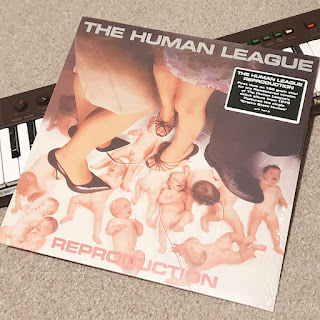And so we come to the "difficult second album" that isn't a second album. I own two copies of "Hysteria" on vinyl: an original UK pressing and the yellow version from "The Virgin Years" box set.
Following the success of "Dare" The Human League were under considerable pressure to produce another hit album. This pressure seemed to lead to the band locking themselves up in AIR studios and doing little but argue for months on end. There is one, possibly apocryphal tale, that the band were so stymied they spend a whole week just auditioning kick drum sounds.
For some reason the band decided they didn't want to repeat the successful formula that led to "Dare" and dispensed with the services of Martin Rushent. The first producer to be drafted in was Chris Thomas but for various reasons he left the project half way through. It was left to Hugh Padgham to take the half finished multi-tracks and a dysfunctional band and make a record. Yet both Thomas and Padgham are most famous for working with rock acts and their involvement has always struck me as a mismatch. With such a problematic gestation, it is no wonder the end product was so disappointing.
The opening track "I'm Coming Back" has a whiff of "Don't You Want Me" in the chorus but it is far less successful than its illustrious predecessor. The faltering nature of this record is best illustrated by "I Love You Too Much" which was originally produced by Martin Rushent and released on the North American album "Fascination!" The version presented here retains Rushent's original Linn LM1 programming but dispenses with the electronic percussion and churning synths and replaces them with a maudlin pad sound. I can only describe the approach as an "audio smear" which robs the songs of its dynamics and makes it less engaging.
If using rock producers weren't incongruous enough, the band now decide to cover seventies funk song "Rock Me Again & Again & Again (6 times)". There have been several occasions when Philip has tried to record with an American funk/soul affectation and it turns out badly every time. The whole thing is just an auditory car crash.
The single "Louise" sounds a bit sparse but there is enough melody to carry it along. The big hit single "The Lebanon" is a pulsing composition that uses the Lebanese civil war as its subject matter. I read somewhere that the bass guitar on this track was sampled into various AMS DMX units and triggered manually; an indication of how over thought this album was. Yet, as Phil was using a Synclavier II at the time of this album, I think it much more likely that this was used.
The second side kicks off with "Betrayed" which sounds naive and a bit like someone doing an impression of The Human League rather than the band themselves. I'm sure there is a good song somewhere within "The Sign" but the execution is so bad it's hard to tell. "So Hurt" is another limp pop song propped up by Ian Burden's bass and the familiar Linn drum machine. History tells us the drum programming for single "Life On Your Own" took a whole week and whilst there are lots of other nice touches that make this an entertaining track, you can't help think it was a little overthought. The final track "Don't You Know I Want You" is a fittingly disappointing finale that only serves to show off the presets in their new Yamaha DX7 .2/5









